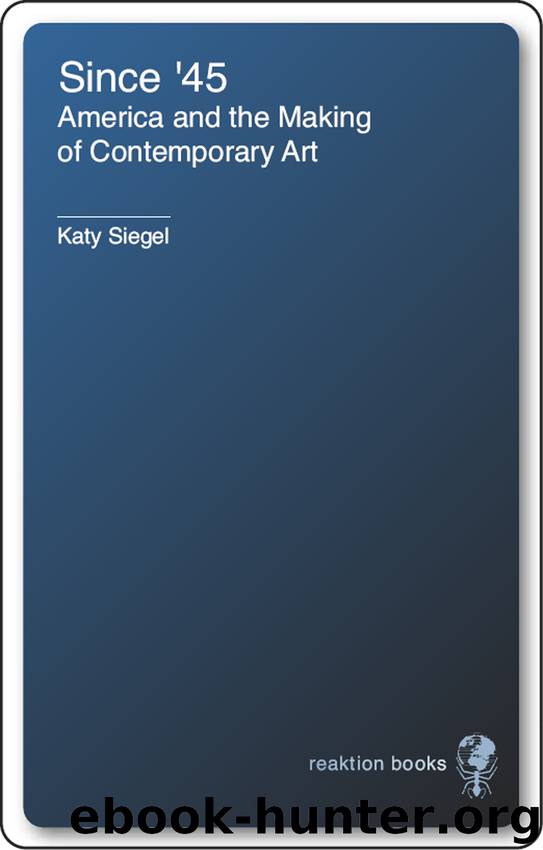Since '45 by Katy Siegel

Author:Katy Siegel
Language: eng
Format: epub
Publisher: Reaktion Books
Art for the Millions
The question of individual taste springs from the nineteenth century, in which the self-cultivation and self-reliance of Thoreau and Emerson was pitted against a more paternalistic branch of elite disseminators of culture like Frederick Law Olmsted and Charles Eliot Norton, in harmony with Matthew Arnold, who tried to impose standards and rules of decorum on a basically pluralist society, particularly the “lawless classes,” as Olmsted referred to the working-class people of New York City.2 (Complicating this dialectic are the facts that Emerson himself, while promoting individual autonomy, saw the “mob” as incapable of it, while even middlebrow hustlers such as P. T. Barnum often framed their entertainments as morality-instilling.) The later version of this conflict between the individual as an authority, sovereign over himself, and a larger therapeutic culture of the expert has been strong in contemporary art since 1945, particularly in the institutions of art’s presentation and understanding. Robert Henri wrote in a letter of 1916, reprinted in The Art Spirit: “If anything can be done to bring the public to a greater consciousness . . . of the part each person plays by exercising and developing his own personal taste and judgment [sic] and not depending on outside ‘authority’, it would be well.”3 This was in tacit contrast with the American inferiority complex about art, the feeling that art was something outside America, that even the sensitive and the wealthy were somehow uncouth, and needed to look to European models for edification and refinement.
The idea that “everyone” in America was potentially both an artist and an art audience member was especially strong in the WPA program. While today murals and employment projects for artists are its best-known aspects (along with the documentary photography in the FSA), it also had a tremendous project of art education or appreciation. Holger Cahill, a champion of American folk art and director of the WPA’s Federal Art Project from 1935 to 1943, was a leading proponent of this version of art. In a speech in honor of John Dewey’s eightieth birthday in 1936, Cahill extolled Dewey’s vision of a plural, educated public, reflected in the new life of art in America:
Portfolios of American art of the past and present are now being circulated through our museums, libraries and schools. In the past month, three or four large books on American art, handsomely printed and profusely illustrated in color, have been published . . . In the past week probably tens of thousands of classes in the arts and art appreciation have met in these United States . . . We now have a sweeping renaissance of democratic interest in American art which runs through every level of our society, from the richest to the poorest.4
Cahill emphasized that this democratic community participation in art was not implicit in modern European society, and that even many American museum directors and artists, still looking to Europe, considered themselves politically liberal but held an elitist, authoritative vision of art.
The WPA aimed to produce both a mass audience and art for it.
Download
This site does not store any files on its server. We only index and link to content provided by other sites. Please contact the content providers to delete copyright contents if any and email us, we'll remove relevant links or contents immediately.
The Secret History by Donna Tartt(18228)
Red Sparrow by Jason Matthews(5204)
Harry Potter 02 & The Chamber Of Secrets (Illustrated) by J.K. Rowling(3559)
In a Sunburned Country by Bill Bryson(3377)
Drawing Cutting Edge Anatomy by Christopher Hart(3302)
Figure Drawing for Artists by Steve Huston(3277)
Harry Potter and the Prisoner of Azkaban (Book 3) by J. K. Rowling(3125)
The Daily Stoic by Holiday Ryan & Hanselman Stephen(3116)
Japanese Design by Patricia J. Graham(3006)
The Roots of Romanticism (Second Edition) by Berlin Isaiah Hardy Henry Gray John(2826)
Make Comics Like the Pros by Greg Pak(2763)
Stacked Decks by The Rotenberg Collection(2699)
Harry Potter and the Deathly Hallows (7) by J.K. Rowling(2554)
Draw-A-Saurus by James Silvani(2514)
Tattoo Art by Doralba Picerno(2498)
On Photography by Susan Sontag(2494)
Foreign Devils on the Silk Road: The Search for the Lost Treasures of Central Asia by Peter Hopkirk(2389)
Churchill by Paul Johnson(2374)
The Daily Stoic by Ryan Holiday & Stephen Hanselman(2353)
